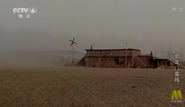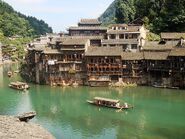Developer Insight: Constantly Iterating on Landmarks[]
After reaching Dihua Marsh, one of the first things players exploring the area will find is the central structure in this area: Wangshu Inn. Sitting atop a towering pillar of rock, it is Liyue's first landmark piece of architecture.
From early on in the very first IP Design Document, the name "Wangshu Inn" was already a foregone conclusion. The head of the development team hoped that this inn would "soothe those who gaze out at the scenery," which is basically the literal meaning of 'wangshu' in Chinese. Incidentally, Wangshu is also one of the aliases of the moon in traditional Chinese — specifically it alludes to the beauty of the moon goddess. In that sense, the view from Wangshu Inn should capture the enchanting beauty of Liyue as a whole, since the 'yue' of Liyue is the more common Chinese term for the moon.
The reference for its conception was "Dragon Inn," a martial arts film well-loved by everyone in the department. Thus, Wangshu Inn inherited the unique feature of the Dragon Inn: while peaceful and pedestrian on the outside, it is in fact the stage for a fierce clash between "crouching tigers and hidden dragons."*
*The "tigers" and "dragons" here refer to people with hidden or unnoticed special talents. Thus, this idiom refers to people to whom there is more than meets the eye.
Wangshu Inn has an excellent vantage point, to the extent that it could pull double duty as a watchtower. On the one hand, this inn is a place where one can expand one's horizons. At the same time, local legend has it that Wangshu Inn is one of the places where the adepti of Liyue gather, a secret base of operations from which they conduct the extermination of monsters in the surrounding area.
And that's not all. The plateau on which Wangshu Inn is built has its own fair share of history as well. According to the IP documents, in a combination of ancient Chinese myths about the dragon Bixi, the Dihua Marsh of antiquity used to experience seasonal floods. In order to avoid disaster, people would build their homes on large rocks, using them to their advantage against the rising waters, and thus escaping damage from flooding.
At the same time, we also considered that the finished structure should look striking when viewed from afar. After referencing ancient stilted buildings and the Xuankong Temple, the facade of Wangshu Inn also began to take shape.
Wangshu Inn was designed to be a home to many characters who are full of surprises. But on a normal day, it is simply a bustling inn. Inns have always been a hub for people on the move, as well as a place where local culture leaves its indelible marks. So it is with Wangshu Inn, the nexus of human activity from Dihua Marsh to the Guili Plains. From porters delivering goods, to traveling merchants, to adventurers... All sorts of people come here, and their experiences become part of the Inn's history.
During the design process, we at the art department often ask ourselves questions such as: What do the people here do every day? How do they get around? After some discussion with the IP department, we were able to derive behavioral norms and ways of living for characters and NPCs based on the larger story world, which we then used to help us design the details. In the current floorplan of the inn, the platform at its base is a resting spot for porters, bedecked with simple tables and chairs, with some tea on the side for guests. As for the water wheel-powered elevator, it is used to ferry guests and goods up and down the floors.
We took the same approach to the interior design. Namely, we first pictured the NPCs' needs, wants and their state of mind before then using these results to create amenities for them.
The other core functions of an inn are the provision of meals and a place to stay. As such, the inn must have also have a kitchen, in which the cooks prepare food and drinks for the guests.
With spaces to eat and stay comes the need for storage space, and so the inn's interior underwent a renovation along the lines of Xuankong Temple. Once the rock's summit had been hewn out, the living space increased drastically. The kitchen was situated on the bottom floor of the inn, allowing guests at the reception area to gaze down at the busy kitchen, while heading from reception to the second floor would allow one to take in all the sights of Dihua Marsh at a single glance.
So that's a small part of our design concept for the Dihua Marsh area. At present, Liyue is home to many more interesting locales, many of which we are furiously working on as we speak.
We will continue to dig deep and improve on the twin aspects of flair and finesse, and strive toward creating more interesting and top-quality content, in order to bring you a better and more complete experience.
Many thanks to everyone who read up to this point. I'm Ziyuan. Let's meet again sometime!







